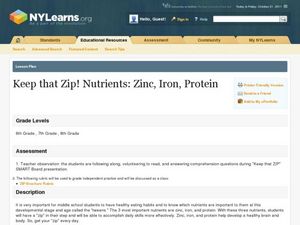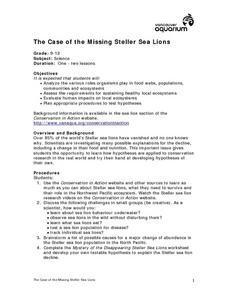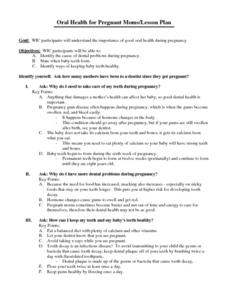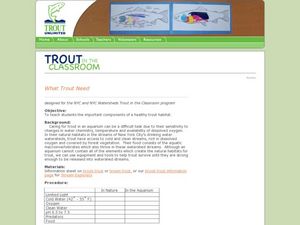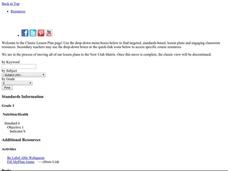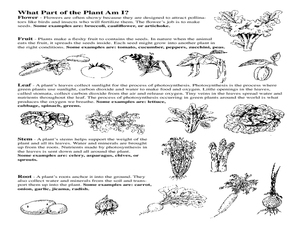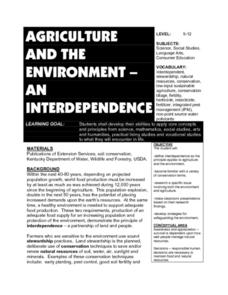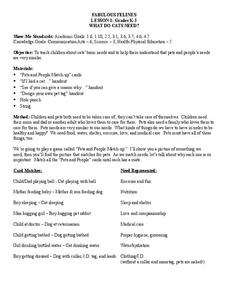Curated OER
Keep that Zip! Nutrients: Zinc, Iron, Protein
Students explain the importance of zinc, iron and protein. In this biology lesson, students create a brochure containing information about the three nutrients. They share their brochure in class.
Curated OER
The Case of the Missing Steller Sea Lions
Students identify and analyze the various roles organisms play in food webs, populations, communities and ecosystems. Students assess the requirements for sustaining healthy local ecosystems. STudents evaluate human impacts on local...
Curated OER
Health and Immunization
Students research facts about Niger and Madagascar before reading a child's case study and answering questions about malaria prevention. They discuss healthy lifestyle, how bacteria and viruses can affect health and that following...
Curated OER
Oral Health for Pregnant Moms
Students identify the cause of dental problems during pregnancy. They state when baby teeth form. They identify ways of keeping baby teeth healthy.
Curated OER
Tiny Bites: What Difference Could They Make?
Students explore how small "extra" bites of food can add significant calories to their diet. They estimate how many extra calories they add to their diets by just taking small bites of food throughout the day.
Curated OER
There Are Algae in Your House!
Young scholars demonstrate that, although we sometimes can neither smell nor taste them, many ingredients in our foods and household products come from the sea. They also investigate food eat to determine algae derivatives they contain.
Curated OER
Health Ball
Second graders participate in a game in which they discover tips for a healthy lifestyle. They discuss that the decisions they make now affect the rest of their lives. They ask any questions they have to end the instructional activity.
Curated OER
Body Composition Tag
Young scholars are in two groups the "fat cells," are a group of 2 or 3 taggers, the rest of the class is lean body tissue. Students have two areas in the gym that are safe zones (nutrition and rest). Young scholars who enter the...
Curated OER
What Trout Need
Students investigate the important components for a healthy trout habitat. In this fish habitat lesson, students discuss how the aquarium will simulate a trout's environment in nature. Students complete a trout information sheet to set...
Curated OER
How Can We Prevent Type 2 Diabetes
Students summarize research they have conducted on Type 2 Diabetes. Students identify healthy lifestyle choices and set goals for their personal health. Students reflect on their research findings in a journal entry.
Curated OER
Indicator Species
Students explore the ecological foundation of India's and ways to save the forests, water and the India tiger. After a lecture on identifying a healthy forest and the importance of the animals, students participate in activities to...
Curated OER
Goobers. Goobers? Goobers!
Students begin the activity by noting the many ways in which to use peanuts. In groups, they use the internet to research the work of George Washington Carver. They discover the allergies and nutritional information of the peanut and...
Curated OER
Laws of the Jungle
Students build a video game on predator-prey relationship. In this biology lesson, students identify the variables that affect this relationship. They write a short description and play each other's game.
Curated OER
Grocery Store Problem Solving
Third graders practice mathematical problem solving skills. In this problem solving lesson, 3rd graders develop mathematical problem solving skills using real-world examples.
Curated OER
Plant Party
Students identify plant parts. In this plants lesson, students bring in a vegetable. Each student classifies which part of the plant their vegetable comes from (flower, root, ect.) Students identify the parts of their vegetable and later...
Curated OER
Physical Activity and Energy
Does smiling take as much energy as running a lap around the track? Everything the body does requires energy. The more vigorous the activity, the more energy the body requires to perform the activity. Compare different low-energy...
Curated OER
Agriculture and the Environment
Students investigate the interdependence of agriculture and the environment. They research areas of interdependence and provide examples of situations where farmers are practicing conservation in the local area. Their findings are...
Curated OER
Asthma and Allergies
Your health class reads two biographical stories: one about a girl who has allergies and the other about a girl who has asthma. They watch a quick cartoon on the KidsHealth website about immunity and take the related online quiz. You...
Curated OER
How Balanced Are You?
Young learners take a look at what they eat in one day and compare it to how much physical activity they do on that same day. Point out that this is only a one-day glimpse at balancing the energy going in and what energy being used. They...
Curated OER
Agriculture Shapes Kentucky History
Young scholars explore the lives of early American Indians and settlers in Kentucky. They describe the agricultural practices of Indians native to Kentucky and develop a supply list for a group of settlers coming to the state to...
Curated OER
Fabulous Felines
Students explore basic needs through discovering that pets and people need very similar things. They will play matching games, sing songs, read books, and discuss the needs of people and animals.
Curated OER
Full Esteem Ahead
Young learners who feel good about themselves will fare better in the long run than those who do not have a high level of self-esteem. Introduce youngsters to what it means to like themselves. Discuss positive characteristics and...
Curated OER
Farmers - Caretakers of the Land
Students explore resource management, specifically farming. After reviewing vocabulary words, groups of students explore what is conserved by each practice. They compare and contrast responses. Students describe farming procedures which...
Curated OER
How Balanced Are You?
Help young learners look at energy in and energy out. Discuss how different activities may require different amounts of energy in. Use the included worksheet to have them write or draw pictures of what they ate in one day and what...


